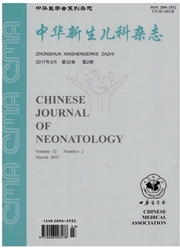

 中文摘要:
中文摘要:
目的探讨广东省早产儿视网膜病(ROP)的防治现状。方法采取分层随机抽样的方法,从广东省13个地级市抽取有能力开展新生儿医疗服务医院152家,对经过培训的医院负责人派发《广东省ROP防治现状及影响因素调查表》,调查新生儿科专用仪器设备、从事ROP的人员和培训情况、开展ROP相关设备、ROP防治情况等,最终回收调查表122份,回收率80.26%。共122家医院纳入研究,其中三级医院50家,二级及以下医院72家。经质量控制后采用SPSS19.0软件对资料进行统计学分析。结果三级医院开展氧疗监测(X^2=18.639,P〈0.01)、ROP筛查(X^2=40.054,P〈0.01)、ROP治疗(X^2=8.262,P〈0.05)情况均好于二级及以下医院。ROP防治主要制约因素为人才、技术、设备缺乏,尤其是专业人才、技术缺乏,三级与二级及以下医院在无专业人员方面比较差异有统计学意义(X^2=4.520,P〈0.05);63家开展筛查的医院中,16家不具备筛查设备的医院通过转诊或聘请外院专家携带筛查设备定期来院指导开展筛查工作;59家不具备筛查能力的医院,对有高风险的患儿通过转诊实施筛查或者请外院专家会诊。结论广东省三级医院ROP防治工作开展较好,而二级及以下医院ROP防治能力弱;ROP防治制约因素主要是人才、技术、设备缺乏;对于不具备筛查能力的医院通过转诊开展区域性合作筛查,通过资源共享,可提高广东省ROP总体防治水平。
 英文摘要:
英文摘要:
Objective To investigate the present situation of retinopathy of the prematurity(ROP) in Guangdong Province. Methods A total of 152 hospitals engaged in neonatal medical service were selected from 13 cities in Guangdong Province by stratified random sampling method. The questionnaires of present situation and influential factors for ROP in Guangdong Province were distributed to the hospital officers to survey the special equipment in the Neonatnlogy Department, ROP specialists and their training collected, the collected related equipment and the present situation of the disease,et al. Eventually, 122 questionnaires was collected, and the return rate was 80.26%. One hundred and twenty -two hospitals entered into the study,including 50 tertiary hospitals ,72 secondary and primary hospitals. Statistical analysis was done with SPSS 19.0. Results Tertiary hospitals were better than secondary and primary hospitals in terms of conducting the oxygen monitoring (X^2 = 18. 639,P 〈0.01 ) ,ROP screening (X^2 =40.054,P 〈0.01 ) and ROP treatment(X^2 = 8. 262,P 〈0.05). The restriction factors in the present situation of ROP were lack of specialists,tech- nology and equipment, especially the first two factors. The difference in lack of specialists and technology between tertia- ry hospitals and the lower- level hospitals was significant (X^2 = 4. 520,P 〈 0.05). There were 63 hospitals able to conduct ROP screening, and 16 hospitals without equipment could carry out ROP screening through referral or inviting the experts from other hospitals. Fifty - nine hospitals which couldn't carry out ROP screening had to refer patients to other hsopitals or invite the experts from other hospitals for consultation of high risk patients. Conclusions The present situation of ROP in the tertiary hospitals in Guangdong Province is generally satisfactory, while that in the secondary and primary hospitals stays behind. The constraints for present situation of ROP examination and treatment were lack of specialists, tech
 同期刊论文项目
同期刊论文项目
 同项目期刊论文
同项目期刊论文
 期刊信息
期刊信息
